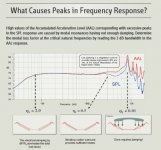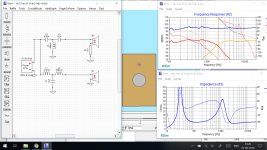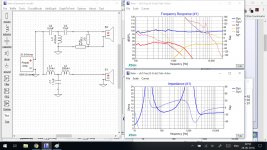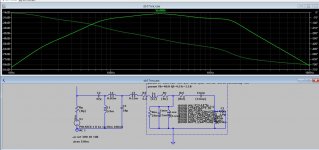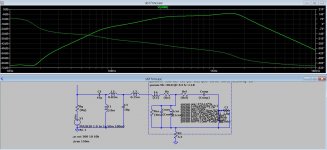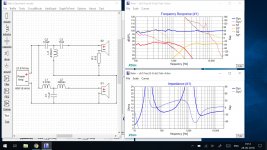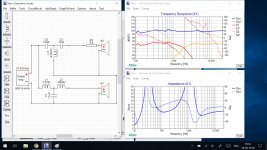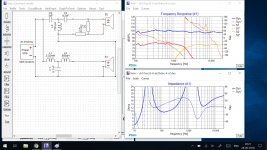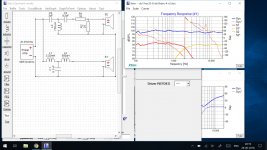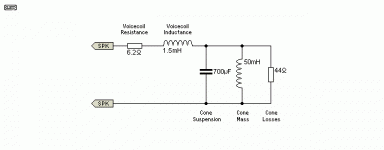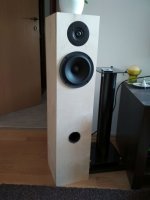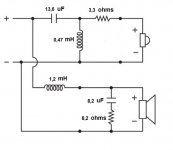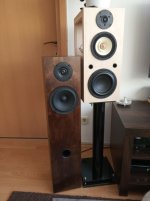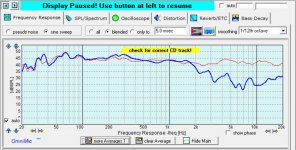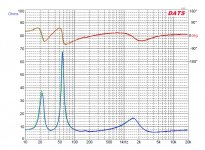I'm thinking I really don't like the look of these SB drivers at all...
6" SB17NRXC35-8 :: SB Acoustics
That is really a plain underdamped cone, like the Klippel metal cone below.
Probably most people regard it as a poor man's Satori. Well, the Satori is an entirely different near fullrange animal like the Scanspeak Ellipticor 18W/4542-T00:
ScanSpeak-Ellipticor-1
Troels even uses the Ellipticor on a 3kHz crossover in a three way:
Ellipticor-4
Where you have cone breakup to deal with, here around 5kHz, my feeling is first get a driver that doesn't have too much of it. Secondly design a filter with good cone damping.
By separating the bafflestep and the rolloff, Michael Chua has made a filter with almost flat impedance and good electrical cone damping. He says it sounds good. Despite a frequency response with low rolloff that looks troublesome on my sim.
Seas ER18RNX with 27TDFC
The usual ca. 2mH/10uF 6" bass filter just doesn't sound all that good. We've all tried it.
I would take away a few things here.
1. A bit of time alignment with 6" is a good thing. Set the tweeter back 2.5 cms and phase falls into place nicely.
2. Get a 6" cone with more controlled behaviour at breakup. The SEAS U18 and Peerless 830874 and 830875 look good on that.
3. Use Michael Chua's bass filter, maybe with an second order tweeter filter with a bit of regular attenuation after the filter, that also happens to have excellent output impedance. Both sections allow the drivers to see a source impedance below 8 ohms. It has unusual passive RL bafflestep, a regular second order LC filter and RC impedance equalisation (Zobel) on the woofer.
6" SB17NRXC35-8 :: SB Acoustics
That is really a plain underdamped cone, like the Klippel metal cone below.
Probably most people regard it as a poor man's Satori. Well, the Satori is an entirely different near fullrange animal like the Scanspeak Ellipticor 18W/4542-T00:
ScanSpeak-Ellipticor-1
Troels even uses the Ellipticor on a 3kHz crossover in a three way:
Ellipticor-4
Where you have cone breakup to deal with, here around 5kHz, my feeling is first get a driver that doesn't have too much of it. Secondly design a filter with good cone damping.
By separating the bafflestep and the rolloff, Michael Chua has made a filter with almost flat impedance and good electrical cone damping. He says it sounds good. Despite a frequency response with low rolloff that looks troublesome on my sim.
Seas ER18RNX with 27TDFC
The usual ca. 2mH/10uF 6" bass filter just doesn't sound all that good. We've all tried it.
I would take away a few things here.
1. A bit of time alignment with 6" is a good thing. Set the tweeter back 2.5 cms and phase falls into place nicely.
2. Get a 6" cone with more controlled behaviour at breakup. The SEAS U18 and Peerless 830874 and 830875 look good on that.
3. Use Michael Chua's bass filter, maybe with an second order tweeter filter with a bit of regular attenuation after the filter, that also happens to have excellent output impedance. Both sections allow the drivers to see a source impedance below 8 ohms. It has unusual passive RL bafflestep, a regular second order LC filter and RC impedance equalisation (Zobel) on the woofer.
Attachments
You are right on the money regarding wanting a poor man's satori. I have a pair of MW16P-4 doing duty in the car with active DSP. I wanted something similar but cheaper.
The other driver I had in mind but rejected due to low efficiency was the SB17NAC35-8. with Alu cone.
But I absolutely got to rethink the tweeter decision If I go with the Alu Cone version, as There will be more than to 10 db sensitivity difference between drivers after compensating for baffle step. May be I will go with the smaller brother SB21RDC
The other drivers you mentioned are either too expensive or dont go low enough.
The other driver I had in mind but rejected due to low efficiency was the SB17NAC35-8. with Alu cone.
But I absolutely got to rethink the tweeter decision If I go with the Alu Cone version, as There will be more than to 10 db sensitivity difference between drivers after compensating for baffle step. May be I will go with the smaller brother SB21RDC
The other drivers you mentioned are either too expensive or dont go low enough.
One nice way to move tweeter back could be waveguide, for example Monacor wg-300. It also helps minimize baffle edge diffraction and match directivities of drivers. Amphion Argon 3S is good example.
I am not sure how to go about designing a wave guide. Moving the Woofer forward is simple and manageable solution for me.
Like the looks of the Argon3s .The waveguide integration into the design in Amphion Argon 3S is very well done.
SB Acoustics advertises that their paper cones are: "EGYPTIAN PAPYRUS fibres made in-house"
I wonder... are the aluminum cones made from: "American beer cans recycled in house?"
=========
If your amplifier can easily drive a 4-ohm load, you can get about 85db sensitivity using the 4-ohm SB17NAC35-4 as Troels did in his 61-NAC. Some measurements show lower distortion for the 4-ohm version than the 8-ohm version.
------
I'm still a fan of using an L-Pad on the tweeter so the tweeter's small dynamic current variations are not lost in a larger value series resistor to ground. If a higher Zmin is still necessary, add a modest value resistor between the amplifier and crossover. Check Troels tweeter crossovers: L-Pad or/and resistor at the amplifier.
I wonder... are the aluminum cones made from: "American beer cans recycled in house?"
=========
If your amplifier can easily drive a 4-ohm load, you can get about 85db sensitivity using the 4-ohm SB17NAC35-4 as Troels did in his 61-NAC. Some measurements show lower distortion for the 4-ohm version than the 8-ohm version.
------
I'm still a fan of using an L-Pad on the tweeter so the tweeter's small dynamic current variations are not lost in a larger value series resistor to ground. If a higher Zmin is still necessary, add a modest value resistor between the amplifier and crossover. Check Troels tweeter crossovers: L-Pad or/and resistor at the amplifier.
SB Acoustics advertises that their paper cones are: "EGYPTIAN PAPYRUS fibres made in-house"
I wonder... are the aluminum cones made from: "American beer cans recycled in house?"



Well they cant market it as " Standard paper cone" can they, They are just so magical and all...
=========
If your amplifier can easily drive a 4-ohm load, you can get about 85db sensitivity using the 4-ohm SB17NAC35-4 as Troels did in his 61-NAC. Some measurements show lower distortion for the 4-ohm version than the 8-ohm version.
------
I'm still a fan of using an L-Pad on the tweeter so the tweeter's small dynamic current variations are not lost in a larger value series resistor to ground. If a higher Zmin is still necessary, add a modest value resistor between the amplifier and crossover. Check Troels tweeter crossovers: L-Pad or/and resistor at the amplifier.
A series resistor should theoretically be the same , before or after the load.
so instead of putting the resistor before the tweeter, where it affects the sound quality, I put it after the tweeter.
same for the lpad. Theoretically we should be able to attach it to negative terminal and still get the same effect.
xsim shows it works... in theory, have to test it out,
Attachments
SPICE simulations with SPICE speaker models show differences when the attenuation resistor is moved in series with ground.
Your Network is not just a simple resistive load. It has capacitors and Inductors.
I just consider the speaker as a 4 ohm resistive load. I am sure that Xsim works with some sort of spice libraries in the backend.
Attachments
Last edited:
As long as resistive load part of the network is kept separate, you can simply attach the resistors before or after the tweeters to the same effect. Even applies to an l-pad. However any inductors or capacitors in between cause the output to vary.
Attachments
SPICE simulations with SPICE speaker models show differences when the attenuation resistor is moved in series with ground.
I Just came across spice simulation example on this site
Loudspeaker enclosure calculating with Thiele Small parameter
I think the difference in output may be due to the inclusion of box parameters in your circuit. Can you try simulating only the speaker without the box parameters and check the output again?
That's probably because in the second example you are measuring the voltage across both the speaker and the resistor because LTSpice measures voltages with reference to ground by default. The reference for the speaker is no longer ground when you move the resistor.SPICE simulations with SPICE speaker models show differences when the attenuation resistor is moved in series with ground.
To tell it to measure a voltage with a reference other than ground, right click the node at the top of the resistor connected to ground and select "Mark Reference", then select the voltage node at the other side of the speaker. Now you're measuring voltage across the speaker only, you'll see the trace labelled like "V(N001,N002)" which means the voltage between N001 and N002. To reference ground again just right click ground and select mark reference.
Last edited:
Hello!
I build a pair loudspeaker with 17RNX and 29RDC.
The NRX sounds not that good, how I hoped - MFC and NAC is a better choose.
The crossover is very simple, 2kHz 6dB/o for the woofer with impedance correction and 12dB/o, Butterworth for the tweeter. Now they are under printing, I will upload measurements, when I get them back.
I build a pair loudspeaker with 17RNX and 29RDC.
The NRX sounds not that good, how I hoped - MFC and NAC is a better choose.
The crossover is very simple, 2kHz 6dB/o for the woofer with impedance correction and 12dB/o, Butterworth for the tweeter. Now they are under printing, I will upload measurements, when I get them back.
Attachments
Hello!
I build a pair loudspeaker with 17RNX and 29RDC.
The NRX sounds not that good, how I hoped - MFC and NAC is a better choose.
The crossover is very simple, 2kHz 6dB/o for the woofer with impedance correction and 12dB/o, Butterworth for the tweeter. Now they are under printing, I will upload measurements, when I get them back.
think it might need a bit more complex crossover to tone down the cone breakup of the NRX.
Hello,
Thank you for the simulation.
I have the 8 Ohm version, the imp.correction is 8,2Ohm - I thought it is obvious.
I measured a little cone breakup at 5kHz, but it is better, then the 18dB/o crossover.
"less parts, beter sound" - i think.
Next week I will get them back, I will upload measurements.
I use Dayton Omnimic and Dayton DATS for measuring.
Simulation rarely meet the reality - it is my own experience.
Regads,
Sandor
Thank you for the simulation.
I have the 8 Ohm version, the imp.correction is 8,2Ohm - I thought it is obvious.
I measured a little cone breakup at 5kHz, but it is better, then the 18dB/o crossover.
"less parts, beter sound" - i think.
Next week I will get them back, I will upload measurements.
I use Dayton Omnimic and Dayton DATS for measuring.
Simulation rarely meet the reality - it is my own experience.
Regads,
Sandor
Last edited:
Hello,
Thank you for the simulation.
I have the 8 Ohm version, the imp.correction is 8,2Ohm - I thought it is obvious.
I measured a little cone breakup at 5kHz, but it is better, then the 18dB/o crossover.
"less parts, beter sound" - i think.
Next week I will get them back, I will upload measurements.
I use Dayton Omnimic and Dayton DATS for measuring.
Simulation rarely meet the reality - it is my own experience.
Regads,
Sandor
Will wait for your Measurements
I finished the painting and the crossover.
I forgot to save the measurement, next time, when I will finish the 3way right to the SB.
In the reality the 5-6kHz breakup is not that much. The 1,2mH and the zobel is enough.
The tweeter has high distorsion below 1,5kHz, so i use 6,8uF // 0,47mH - 3kHz LR crossover. The 3,3Ohm series resistor is not enough, need a 10 Ohm resistor parallel with the tweeter.
I found another plan for this speakers, try to attach.
S
I forgot to save the measurement, next time, when I will finish the 3way right to the SB.
In the reality the 5-6kHz breakup is not that much. The 1,2mH and the zobel is enough.
The tweeter has high distorsion below 1,5kHz, so i use 6,8uF // 0,47mH - 3kHz LR crossover. The 3,3Ohm series resistor is not enough, need a 10 Ohm resistor parallel with the tweeter.
I found another plan for this speakers, try to attach.
S
Attachments
I finished the painting and the crossover.
I forgot to save the measurement, next time, when I will finish the 3way right to the SB.
In the reality the 5-6kHz breakup is not that much. The 1,2mH and the zobel is enough.
The tweeter has high distorsion below 1,5kHz, so i use 6,8uF // 0,47mH - 3kHz LR crossover. The 3,3Ohm series resistor is not enough, need a 10 Ohm resistor parallel with the tweeter.
I found another plan for this speakers, try to attach.
S
Thanks you!
I did finish my speaker, with help from my local audio component dealer who sells SB drivers.
And My experience has been the same as you described. Measurements yield a different result from simulations.
And even a crossover design done after inputting the measured frds has a slight variation from expected result. had to do some minor changes to get the final result.
My design is put up for sale here by SB acoustics dealer as a finished Kit.
Eight Audio Pearl 2way Bookshelf Speaker - Teak Wood – Eight Audio(R)
I did a quick measurement.
Only cover the tweeter to show how the woofer increase at 5kHz.
It is from 30cm, so from off-axis and more distance this hump is not so bad.
(red is the total and blue is the woofer covered tweeter)
The impedance does not fall below 6 Ohms thanks to the l-pad before the tweeter.
Now it is long listening and good bass rendering budget 2way speaker.
I like them very much.
Regards,
Sandor from Hungary
Only cover the tweeter to show how the woofer increase at 5kHz.
It is from 30cm, so from off-axis and more distance this hump is not so bad.
(red is the total and blue is the woofer covered tweeter)
The impedance does not fall below 6 Ohms thanks to the l-pad before the tweeter.
Now it is long listening and good bass rendering budget 2way speaker.
I like them very much.
Regards,
Sandor from Hungary
Attachments
- Status
- This old topic is closed. If you want to reopen this topic, contact a moderator using the "Report Post" button.
- Home
- Loudspeakers
- Multi-Way
- crossover design sb17nrx ,sb29rdnc. Will this work?
